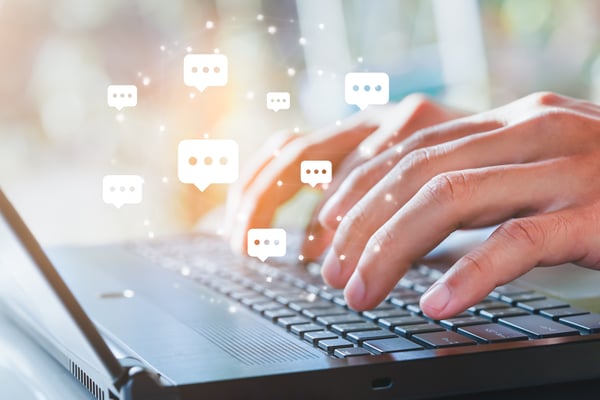Co-authored by Michelle Lippert and Brooks Thompson
Watch it on demand by clicking here.
How many times in the last week have you used the “thumbs up” emoticon? If you use iMessage, Facebook, Teams, Skype, or one of the countless other chat and collaboration tools on the market today, it’s a safe bet that you’ve given the “thumbs up” at least once this week. Did that “thumbs up” mean you agreed with the message or were you simply confirming you viewed it? Are you sure the person receiving that message interpreted it the way you intended (or that they even saw the same “thumbs up” image that you did)?

To give you a sense of just how much we are using this new type of language, consider the fact that five BILLION emoticons are sent on Facebook Messenger a day. Emoticons, emojis, gifs, and shorthand abbreviations are clearly changing the way we communicate, both in our everyday lives and at work (which in this post-COVID world, increasingly blend together). This, in turn, affects organizations at almost every level and therefore also affects how we must plan for and conduct investigations, ediscovery, and compliance.
Recently, we had the opportunity to discuss this topic with a few ediscovery industry leaders. Below is our recap of that conversation - we promise it won’t elicit a TLDR[1] response.
Current Climate
While the use of chat platforms was already proliferating in workplaces pre-pandemic, the post-COVID world has monumentally compounded not only the amount of people using these platforms, but also how much they’re using them and the scenarios in which the platforms are being used. Industry leaders are seeing a seismic shift to Teams, Slack, Zoom, Skype, and their corresponding applications for phones. Companies should be aware that there are key differences in the security and retention of data between the free and enterprise licensed versions of these applications, and will need to plan for those differences in their employee policies, retention schedules, and collection plans.
Organizations will also need to consider the HR implications of the expanded use of these types of applications. For example, wage and hour investigations that traditionally would have primarily focused on keycard swipes to/from a physical building are now muddled by remote work schedules and questions around when an employee logged in to which applications and whether those logins were audited, etc. The increase in remote working also increases the potential for the comingling of private communications and work communications, and the potential that this comingling may take place on devices and platforms that are subject to collection in the event of litigation or investigation. Employees should be aware that it is much harder to parse out data on collaboration tools, meaning that the family drama they gossiped about on a Teams channel before the conversation turned work related may ultimately end up in a deposition or courtroom.
Translating New Communications
Interpreting the meaning of emoticons, emojis, gifs, and shorthand for evidentiary purposes can be a Sisyphean task. Generational, contextual, and cultural differences can lead to a wide range of interpretations among senders, receivers, HR professionals, and legal counsel. A thumbs up among teammates who commonly use the emoji to signify that they are going to take action on an item may have a completely different meaning among non-teammates. Adaptation of this new casual language has also been much easier for younger generations and may not have the same meaning to someone older. If the meaning and interpretation of this type of “language” is important to an investigation or litigation, it will be important to interview both parties to understand what the intent was as well as how it was received.
Common Challenges
As you can imagine, there are a number of hurdles to jump over for those tasked with monitoring, preserving, collecting, reviewing, and producing this new type of “language.” For those tasked with combing through data: your investigational skills will need to be more focused. Predictive coding technology will not be able to run a straightforward search for emojis or gifs. You will need to focus more on the timing of communications and who is talking to whom within an organization. Additionally, consider utilizing online resources that convert emojis to text. This type of translation can help you develop a “smoking gun” list of searchable text that can aid in detecting emoji use that may indicate harassment or mal intent.
For those tasked with collecting and producing this data, you will need to talk to your IT teams and ediscovery vendors to ensure that you can actually access and collect the data you need, as well as display it in a way that replicates how it looked when it was sent. Adding to the “translation error” potential is the fact that the emojis and symbols themselves may vary between the sender and receiver depending on what applications and what version of those applications both are using. A smiley face may turn into a text “J” if the receiver doesn’t have the ability to receive emojis on the application they are using to view the message. A “ghost” emoji may look completely different between the sender and receiver, depending on the iOS version. When interpretation is important to an investigation or litigation, verify the application and versions of those applications both the sender and receiver were using at the time the message was sent and, if possible, collect the communication from both sides.
Ephemeral data (or self-destructing message applications) can also pose a challenge. The DOJ famously released guidance around these types of applications, prohibiting their use in certain cases because of the possibility of business record destruction. Often these data sources may be okay for casual employee use, but organizations should consider putting an enforceable and coherent policy in place around their use.
Relatedly, a major challenge for all this new data is, in fact, retention. If you know employees are using applications for work purposes, then those applications need to be a part of your legal hold strategy and flagged for counsel as soon as you know of anticipated litigation. Also, be aware that platforms may have different retention timelines depending on whether they are on a computer or on a phone application. Your IT teams need to understand those differences and also need to stay on top of all software updates and changes. Data management and information governance policies need to be updated and revisited often, employees need to understand these policies, and the policies need to be reiterated and enforced.
Best Practices Short List
- Be sure to develop a well-rounded data retention plan, adjust as needed, and retire when it comes time.
- Ensure company policies stay up to date by monitoring and managing them on a pre-planned cadence.
- Develop a smoking gun list to catch common communication concerns, explicit, or inappropriate content.
- Assess and understand the case type so that you have a complete view of what you may need to extract at collection time.
To continue the conversation, please reach out to us at info@lighthouseglobal.com.
[1] Millennial acronym definition: “Too long; Didn’t read”
